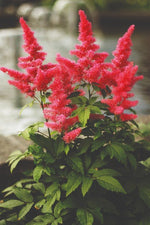
Visions In Red
675
About Visions in Red
Introduce a splash of color to your garden with the Astilbe Visions in Red! This beautiful perennial is perfect for adding a pop of color to your shaded areas. With its deep red blooms and lush green foliage, this plant is sure to be a standout in your garden.
- Dark red blooms that will add color to your garden all season long
- Perfect for shaded areas, making it a great addition to any garden
- Lush green foliage that will add texture and depth to your garden
- Easy to care for and maintain
- Can reach a height of 28" tall
How to care for Visions in Red
- Choose a spot in your garden that has well-drained soil and partial to full shade.
- Dig a hole that is slightly larger than the root ball and place the plant in the hole, making sure the top of the root ball is level with the soil surface.
- Backfill the hole with soil and press down firmly.
- Water the plant regularly and keep the soil consistently moist.
- Fertilize the plant once a month during the growing season with a balanced fertilizer.
- Prune the plant back to the ground in late fall to encourage new growth in the spring.
FAQs

